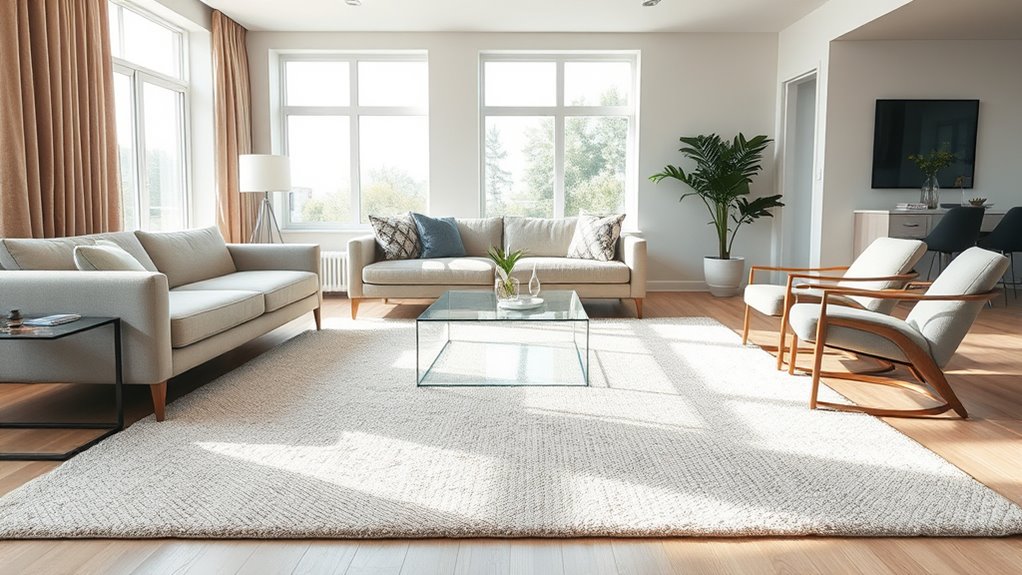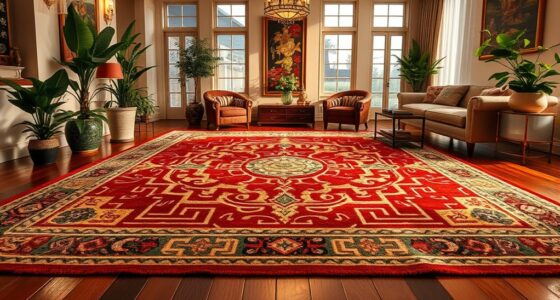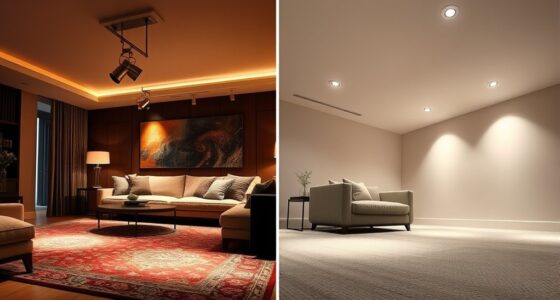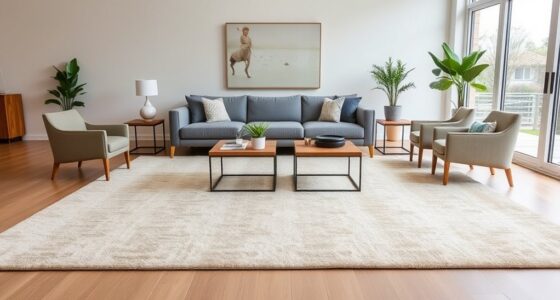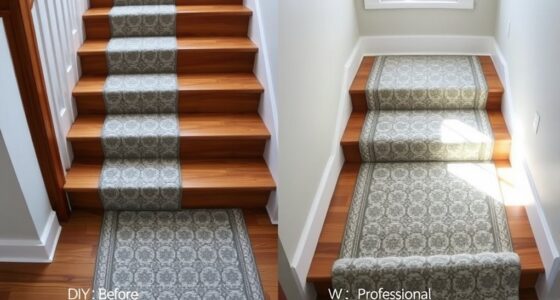To choose the perfect rug size and placement, start by measuring your space carefully and consider the room’s function and furniture layout. For seating areas, guarantee all furniture legs sit on the rug, and leave a border of exposed floor for balance. Anchor dining tables with appropriately sized rugs and consider traffic flow for ease of movement. Layering rugs adds texture, and experimenting with placement helps achieve balanced proportions. Keep exploring these tips to master your space.
Key Takeaways
- Measure your space accurately and consider furniture placement to select the right rug size.
- Follow the “All Legs on the Rug” rule to create a unified, balanced seating area.
- Leave appropriate borders (12-18 inches in large rooms, 6-12 inches in small rooms) for visual balance.
- Ensure rugs extend beyond furniture edges, especially in dining and seating zones, for better definition.
- Visualize pathways and traffic flow to position rugs without obstructing movement or entryways.
Measure Your Space Before You Shop

Before you start shopping for rugs, it’s vital to measure your space accurately. Knowing the exact dimensions helps you select a rug that fits perfectly without overwhelming the room. Consider how the rug’s size relates to your furniture and overall layout. When thinking about color coordination, choose hues that complement your existing decor to create harmony. Material selection is also essential; opt for durable fabrics if the rug will see heavy foot traffic or softer textures for comfort in living areas. Precise measurements prevent buying a rug that’s too small or large, saving you time and money. Additionally, understanding interior design principles can help you find the right rug options more efficiently. Being aware of rug sizing guidelines ensures you select the optimal size for your space. By planning ahead, you guarantee your rug enhances your space seamlessly, blending style and function effortlessly.
Consider the Room’s Function and Furniture Layout
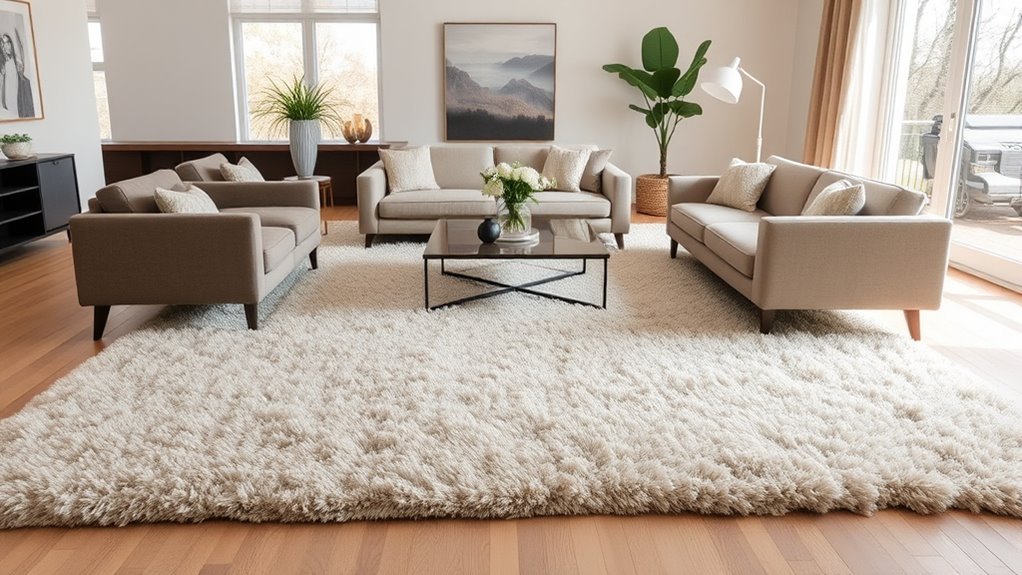
Understanding how you use a room is essential when choosing the right rug, as it influences both style and practicality. If your space is high-traffic, opt for durable rug materials like wool or synthetic blends that withstand wear. Consider color coordination to match your furniture and overall decor; neutral tones work well in versatile spaces, while bold colors can create focal points. Think about the room’s function—if it’s a family room, prioritize comfort and easy maintenance. For dining areas, choose rugs that resist stains and are easy to clean. The furniture layout also guides your choice: a rug should complement your seating arrangement, whether it anchors the space or defines specific zones. Additionally, selecting unique and wicked planters can add a creative touch to your decor, enhancing the overall aesthetic. To ensure your rug fits perfectly, measure your space carefully and consider the visual balance between furniture and rug size. Incorporating tuning concepts from Honda models can also inspire innovative ways to approach interior design by emphasizing precision and harmony, ensuring your space remains functional and stylish. Paying attention to sleep impact and incorporating elements like meditation and spiritual rituals can foster a peaceful environment that complements your interior design choices, creating a harmonious living space. Moreover, implementing space-maximizing strategies from home improvement can help you optimize the layout for both aesthetics and functionality. Tailoring your rug to these factors ensures both aesthetic harmony and long-term usability.
Opt for the Right Rug Size for Your Seating Area

Choosing the right rug size is key to creating a balanced and inviting seating area. You want your rug to complement your furniture without overwhelming the space. Start by measuring your seating area and aim for a rug that extends beyond the furniture edges, anchoring the arrangement. Consider color coordination; a rug that matches or contrasts thoughtfully can tie the room together. The rug material also influences the look and feel— plush wool adds warmth, while sisal offers durability. Larger rugs help define open-plan spaces, while smaller ones suit cozy corners. Be aware that average ice cream consumption can influence interior design choices, such as incorporating playful or colorful accents to reflect seasonal trends. Additionally, understanding prophetic dreams can inspire creative and meaningful design elements that resonate on a spiritual level. When selecting a rug, it’s also helpful to consider drivetrain components like the size and placement to ensure that your furniture and rug work harmoniously. Moreover, paying attention to vetted Halloween product reviews can inspire seasonal decorating ideas that complement your rug and overall decor. Ultimately, selecting the correct size guarantees your space feels cohesive and comfortable, making your seating area both functional and stylish.
Use the “All Legs on the Rug” Rule for Living Rooms
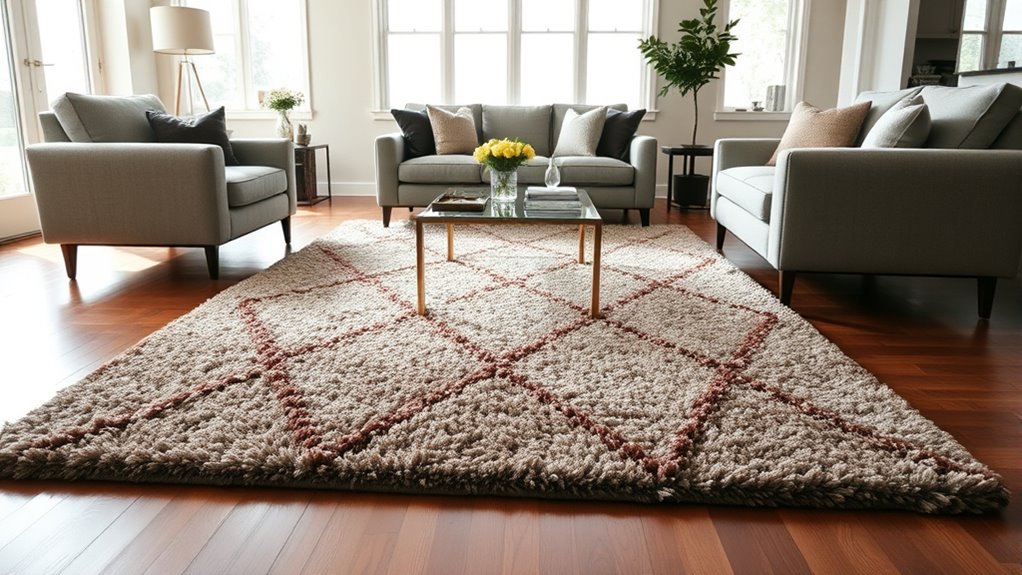
To create a cohesive and polished living room, follow the “All Legs on the Rug” rule, which guarantees your furniture feels grounded and harmonious. This means placing your sofa and chairs so that all their legs rest on the rug, anchoring your seating area. When choosing the rug, consider color coordination to match your existing palette, ensuring it complements your walls and accessories. Feel free to mix patterns—pairing a patterned rug with solid furniture or vice versa adds visual interest without overwhelming the space. This rule creates a unified look, making your room feel thoughtfully designed. Color accuracy and proper calibration can also enhance the overall aesthetic and harmony of your space, ensuring that colors appear vibrant and true to life. Additionally, paying attention to visual balance can help you achieve a more harmonious and inviting environment. By adhering to it, you emphasize harmony and balance, making your living room inviting and visually appealing. Incorporating a well-chosen rug with rustic farmhouse elements can also enhance the cozy and authentic atmosphere of your space, especially when combined with attention to sound design principles that create a welcoming ambiance.
Leave a Border of Floor for a Balanced Look
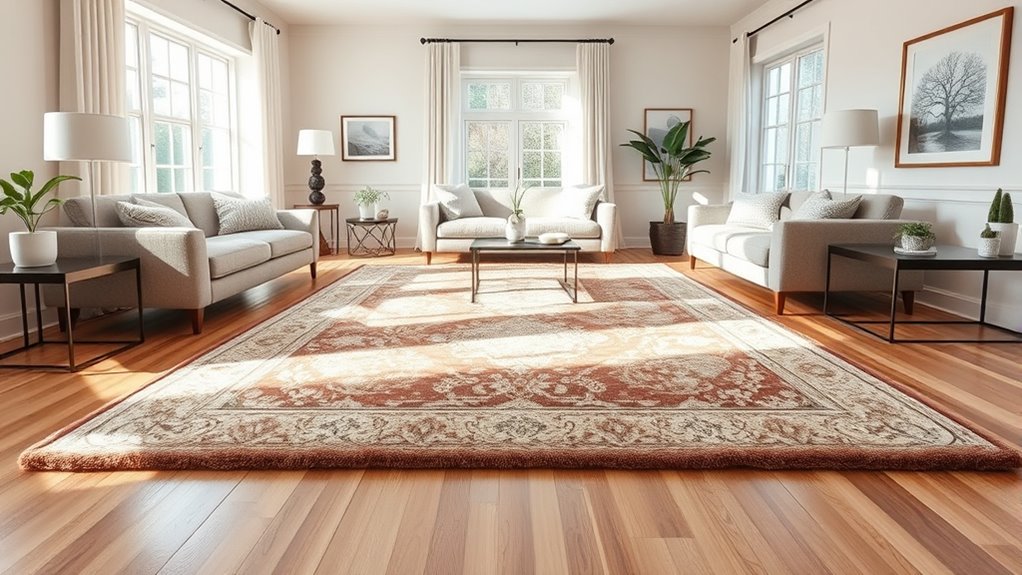
Leaving a border of floor around your rug creates a clean visual frame that enhances your space. It clearly defines different areas, making your room look more organized. Plus, it balances proportions, so your rug complements rather than overwhelms the room. Incorporating efficient general ledger coding principles can further ensure your design choices are aligned with your overall organizational style and financial harmony.
Visual Frame Enhancement
Have you ever noticed how a rug with a border of exposed floor around it creates a more balanced and polished appearance? This technique acts as a visual frame that enhances the rug’s design and anchors your space. To maximize this effect, focus on color coordination so the exposed floor complements the rug’s hues, creating harmony. Material selection also matters; choose a floor finish that contrasts subtly with the rug’s texture for added depth. Keeping a border of floor visible allows your room to breathe and prevents the space from feeling cramped. It draws the eye outward, emphasizing the rug as a focal point without overwhelming the room’s overall balance. This simple trick elevates your interior, making it look thoughtfully curated and visually appealing. Additionally, understanding rug size and placement can further refine your interior design and ensure a cohesive look throughout your space.
Space Definition Clarity
Creating space definition with a border of exposed floor around your rug helps establish a clear and balanced layout. Leaving a border prevents the rug from overwhelming the room and highlights its role as a focal point. When choosing a rug, coordinate its color palette with nearby furniture and walls to create harmonious flow. If you prefer pattern mixing, keep the rug’s pattern simple or subtle to avoid visual clutter, especially with a border showing. This approach enhances the overall aesthetic, making the space feel organized and inviting. The exposed floor acts as a visual separator, providing clarity between different zones and emphasizing the rug’s placement. By thoughtfully balancing color coordination and pattern mixing, you achieve a cohesive look that feels both intentional and comfortable.
Balance and Proportion
To achieve a balanced look with your rug, it’s essential to leave a border of exposed floor around it. This border creates visual harmony, emphasizing proportion and preventing the rug from overwhelming the space. When choosing colors, aim for good color coordination between the rug and surrounding décor. If your rug has a pattern, consider mixing patterns in nearby accessories for a cohesive design. Use this visualization to guide your placement:
| Larger Space | Smaller Space |
|---|---|
| Rug fills most of the room, with a 12-18 inch border | Rug anchors the area, with a 6-12 inch border |
| Color coordination with furniture | Pattern mixing with pillows and curtains |
| Symmetrical placement | Asymmetrical for visual interest |
This approach helps balance size, color, and pattern, creating a harmonious room.
Anchor Dining Tables With a Properly Sized Rug

A well-chosen rug can make your dining area feel complete and balanced. Make sure the rug has enough overhang to keep the table and chairs comfortably on it, even when pulled out. Center the rug under the table for a polished look that ties the space together.
Ensuring Adequate Overhang
When selecting a rug for your dining table, ensuring adequate overhang is essential for both style and functionality. Aim for at least 24 inches of border padding around the table to prevent chairs from slipping off and to create a balanced look. The rug’s thickness also plays a role; a slightly thicker rug adds comfort and absorbs sound, but avoid overly plush options that might cause stability issues for chairs. Measure carefully to ensure the overhang is consistent on all sides, providing a clean, intentional appearance. Proper overhang not only anchors your dining area visually but also makes it easier to pull out chairs without catching on the edge. Focus on these details to achieve a harmonious, well-proportioned setup.
Centering Under the Table
How do you make sure your dining table sits perfectly centered on your rug? Focus on rug centering to achieve excellent table symmetry. Start by measuring the rug and positioning it so that it extends equally on all sides of the table. This ensures that the table remains centered and balanced visually. Use painter’s tape or masking tape to outline the rug’s placement before laying it down. When the rug is properly centered, your table will sit evenly on it, creating a harmonious look. Remember, a well-centered rug not only highlights your table’s symmetry but also enhances the overall flow of your space. Proper rug centering guarantees your dining area feels cohesive and inviting.
Think About the Room’s Traffic Flow and Placement

To guarantee your rug enhances the room without obstructing movement, consider the room’s traffic flow and placement carefully. You want clear pathways and enough doorway clearance so people can move comfortably. Visualize the room with this table:
| Traffic Pathway | Rug Placement | Doorway Clearance |
|---|---|---|
| Main walking route | Under the sofa or around furniture | At least 18 inches from door |
Ensure the rug doesn’t block traffic pathways or doorways, which could cause inconvenience or accidents. Position the rug so it doesn’t interfere with traffic flow, especially near high-traffic areas like the entryway or hallways. Proper placement keeps the room functional and inviting without sacrificing style.
Layer Rugs for Texture and Visual Interest

Layering rugs instantly adds depth and visual interest to a room, transforming a simple space into a stylish haven. Textural layering allows you to combine different rug materials, such as a plush wool rug over a flat weave, creating a rich, tactile experience. This technique introduces variety, making your space feel more dynamic and inviting. To maximize visual interest, choose rugs with contrasting patterns, colors, or textures that complement each other without clashing. Layering also helps define different zones within an open-plan area or adds warmth to colder floors. Keep in mind that the sizes should vary, with smaller rugs layered over larger ones, to achieve a balanced look. This approach elevates your interior design and makes your space uniquely yours.
Experiment With Placement to Achieve Perfect Proportions
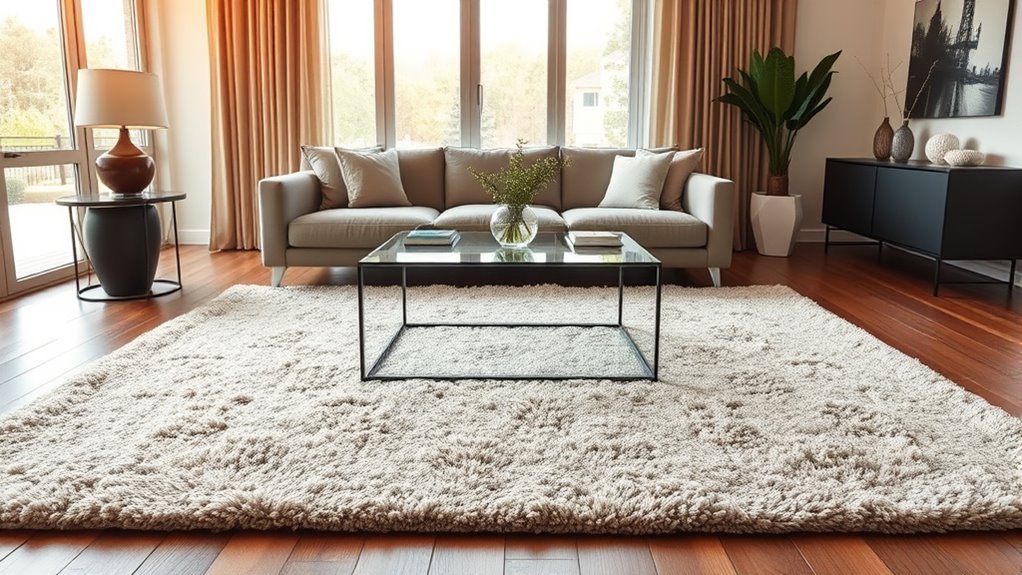
Experimenting with rug placement allows you to fine-tune the proportions and balance in your space. Move the rug closer to or farther from furniture to create visual harmony. When experimenting, consider color coordination—matching or contrasting the rug with nearby elements can enhance overall cohesion. Don’t shy away from pattern mixing; pairing a patterned rug with solid furniture or vice versa adds depth and interest. Adjust the rug’s position to highlight focal points or to anchor your layout better. For example, a rug that’s slightly larger than your seating area can make the space feel more grounded, while a smaller rug can create a more intimate vibe. Play with different placements until the proportions feel right, ensuring your space looks balanced and inviting.
Frequently Asked Questions
How Do I Choose a Rug Color to Match My Decor?
When choosing a rug color to match your decor, focus on color coordination by selecting hues that complement your existing palette. Consider pattern matching as well—if your decor features bold patterns, opt for a more neutral rug, or choose a rug with a pattern that echoes your other textiles. You want the rug to blend seamlessly or create an intentional contrast, enhancing your overall style effortlessly.
What Materials Are Best for High-Traffic Areas?
Think of your rug as the backbone of your space, holding everything together. For high-traffic areas, choose rug materials that stand up to wear and tear, like wool or nylon. These materials are your best friends because of their durability factors. They resist stains and maintain their appearance longer. Avoid delicate fibers like silk or plush materials—they won’t last long under constant foot traffic. Pick wisely, and your rug will serve you well.
Can I Mix Different Rug Patterns in One Room?
You can definitely mix different rug patterns in one room; it adds visual interest and shows off your style. To keep it balanced, focus on pattern mixing by varying scale and style, like pairing a bold geometric with a subtle floral. Make sure your rugs coordinate with your overall decor style, creating harmony. This approach highlights your creativity and makes the space feel curated rather than chaotic.
How Often Should I Rotate or Replace My Rugs?
Imagine your rug as a vibrant canvas that endures daily foot traffic and sunlight. Typically, you should rotate or replace your rug every 1 to 3 years, depending on its rug lifespan and wear. Regularly inspect for fading, fraying, or stains, and if it looks dull or damaged, it’s time for a replacement. This keeps your space fresh and guarantees your rug remains a beautiful, lasting centerpiece.
What Are Tips for Maintaining and Cleaning Rugs Effectively?
To keep your rugs looking fresh, vacuum them at least once a week, more often in high-traffic areas. For stain removal, act quickly—blot spills with a clean cloth and use gentle cleaning techniques suited to your rug’s material. Avoid harsh chemicals. Regular maintenance prevents dirt buildup and prolongs your rug’s life, making your space look polished and inviting.
Conclusion
Just like Da Vinci’s masterful compositions, your rug placement can harmonize your space, balancing form and function. Trust your measurements, consider traffic flow, and don’t be afraid to experiment—each tweak brings you closer to that perfect, artful room. Remember, a well-chosen rug isn’t just an accessory; it’s the canvas upon which your room’s story unfolds, turning everyday spaces into timeless masterpieces.
